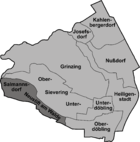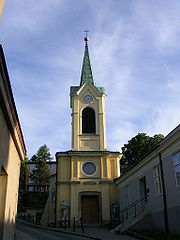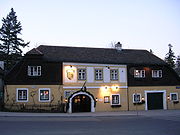
Neustift am Walde
Encyclopedia
| Neustift am Walde | |
|---|---|
| Coat of arms | Map |
 |
 |
Location: 48°15′4"N 16°18′5"E |
|
Until 1892 Neustift am Walde was an independent municipality
Municipality
A municipality is essentially an urban administrative division having corporate status and usually powers of self-government. It can also be used to mean the governing body of a municipality. A municipality is a general-purpose administrative subdivision, as opposed to a special-purpose district...
in the outskirts of Vienna, Austria and is today a part of Döbling
Döbling
Döbling is the 19th District in the city of Vienna, Austria . It is located on the north end from the central districts, north of the districts Alsergrund and Währing...
, the 19th district of Vienna. It is also one of the 89 Katastralgemeinde
Katastralgemeinde
A Katastralgemeinde , a German word , is a cadastral subdivision of municipalities in the nations of Austria, Croatia, the Czech Republic, Slovakia, the Italian provinces of South Tyrol, Trentino, Gorizia, Trieste, and in Slovenia.A cadastral community records property ownership in a cadastre,...
n.
Geography
Neustift covers an area of 209.85 hectares, of which over one third (58 hectares) - largely made up of the Dorotheer Wald (forest) and the Neustifter Friedhof (cemetery) - lie in the district of WähringWähring
Währing is the 18th district of Vienna, Austria. It is in the northwest part of the city. In addition to currently hosting a number of Vienna's foreign embassies, Währing was the site of the original burial places of composers Ludwig van Beethoven and Franz Schubert.-Location:Währing lies in the...
, while the section of Neustift in Döbling (151.85 hectares) includes inter alia the centre of the original settlement.
Neustift lies to the northwest of Pötzleinsdorf, to the west of Sievering
Sievering
Sievering is a suburb of Vienna and part of Döbling, the 19th district of Vienna. Sievering was created in 1892 out of the two erstwhile independent suburbs Untersievering and Obersievering. These still exist as Katastralgemeinden.- Geography :...
, to the east of Neuwaldegg and to the southeast of Salmannsdorf
Salmannsdorf
Salmannsdorf is today a part of Döbling, the 19th district of Vienna.Salmannsdorf was an independent municipality until 1892, when it was incorporated into the Währing district of the city of Vienna. However, in 1938, Salmannsdorf was re-assigned together with Neustift am Walde to the district of...
. The village comprises two long rows of houses, separated from one another by a narrow road that follows the upper section of the Krottenbach stream. A road connects Neustift am Walde with Salmannsdorf and the Krim, a part of Unterdöbling
Unterdöbling
Unterdöbling was an independent municipality until 1892 and is today a part of Döbling, the 19th district of Vienna. It is also one of the 89 Katastralgemeinden.- Geography :...
.
The origin of the name Neustift
The name Neustift appears for the first time in an official document of 1330. It is probably a reference to the creation of a new religious institution (Neu = new, Stift = a monastery or other religious institution) on the edge of the forest (am Walde) to the west of the village of Chlainzing after Chlainzing had been abandoned.Neustift in the Middle Ages

Gars am Kamp
Gars am Kamp is a town in the district of Horn in Lower Austria, Austria....
, who founded the Dorotheastift (St. Dorothea monastery). He gave the monastery possession of Neustift in 1414. By 1435, the settlement could already boast 24 houses.
Neustift since the Middle Ages
Like the neighbouring settlements, Neustift am Walde suffered greatly during both sieges of ViennaSiege of Vienna
The Siege of Vienna in 1529 was the first attempt by the Ottoman Empire, led by Suleiman the Magnificent, to capture the city of Vienna, Austria. The siege signalled the pinnacle of the Ottoman Empire's power, the maximum extent of Ottoman expansion in central Europe, and was the result of a...
.

Maria Theresa of Austria
Maria Theresa Walburga Amalia Christina was the only female ruler of the Habsburg dominions and the last of the House of Habsburg. She was the sovereign of Austria, Hungary, Croatia, Bohemia, Mantua, Milan, Lodomeria and Galicia, the Austrian Netherlands and Parma...
, Neustift once suffered a particularly bad wine harvest. The empress freed the village from paying taxes and in a sign of their gratitude, the vintners brought Maria Theresa a crown made of vine branches. She returned it to Neustift with the command to celebrate the church patron Saint Roch
Roch
Saint Roch or Rocco ; lived c.1348 - 15/16 August 1376/79 was a Christian saint, a confessor whose death is commemorated on 16 August; he is specially invoked against the plague...
every year on 16 August. The crown is kept in the Kronenstüberl restaurant, which belongs to the Eischer family. In 1713, the plague stuck Neustift. In the same year, an Italian merchant donated funds for the Rochuskapelle (Chapel of St Roch) to commemorate its victims. When Joseph II
Joseph II, Holy Roman Emperor
Joseph II was Holy Roman Emperor from 1765 to 1790 and ruler of the Habsburg lands from 1780 to 1790. He was the eldest son of Empress Maria Theresa and her husband, Francis I...
dissolved the Dorotheastift, Neustift am Walde came into the possession of the Stift Klosterneuburg
Stift Klosterneuburg
Klosterneuburg Priory is a Roman Catholic monastery of Augustinian Canons in the Lower Austrian town of Klosterneuburg on the Danube river, just north of the Vienna city limits at the Leopoldsberg....
. Neustift furthermore became an independent parish and the chapel was transformed into the Neustift parish church.
Neustift had a difficult time recovering from the damage done by French troops in the Napoleonic Wars
Napoleonic Wars
The Napoleonic Wars were a series of wars declared against Napoleon's French Empire by opposing coalitions that ran from 1803 to 1815. As a continuation of the wars sparked by the French Revolution of 1789, they revolutionised European armies and played out on an unprecedented scale, mainly due to...
at the start of the 19th century, but from the middle of the 19th century, tourists seeking the area’s fine summer weather triggered an increase in prosperity. Guest rooms were created for wealthy Viennese; several hotels were also opened. Neustift am Walde nonetheless remained a small settlement.
The threat of flooding that Neustift am Walde’s proximity to the Krottenbach brought with it was finally eliminated in 1908/09 when the stream was enclosed after it had flooded the village for the last time in 1907.
In 1892, Neustift am Walde, was combined with Salmannsdorf
Salmannsdorf
Salmannsdorf is today a part of Döbling, the 19th district of Vienna.Salmannsdorf was an independent municipality until 1892, when it was incorporated into the Währing district of the city of Vienna. However, in 1938, Salmannsdorf was re-assigned together with Neustift am Walde to the district of...
, Währing, Weinhaus, Gersthof and Pötzleinsdorf to form the district of Währing
Währing
Währing is the 18th district of Vienna, Austria. It is in the northwest part of the city. In addition to currently hosting a number of Vienna's foreign embassies, Währing was the site of the original burial places of composers Ludwig van Beethoven and Franz Schubert.-Location:Währing lies in the...
, but in 1938 the villages of Neustift am Walde and Salmannsdorf were integrated into the 19th district (Döbling
Döbling
Döbling is the 19th District in the city of Vienna, Austria . It is located on the north end from the central districts, north of the districts Alsergrund and Währing...
). The Neustift cemetery however remained a part of the district of Währing.
Nowadays, Neustift am Walde is popular for its numerous Heurige (restaurants selling locally-produced wine). The well-attended celebration of Maria Theresa’s generosity takes place every year.
Economy
The distribution of available land at the start of the 19th century makes clear the importance of both forests and vineyards for the local economy. In 1826, woods occupied one third of the land, while vineyards and pasture each occupied one quarter. Just 10 percent were used for agriculture.Population growth
In 1435, Neustift am Walde comprised 34 houses. It barely grew in the following centuries. In 1832, there were 38 houses with a total of 307 inhabitants, approximately the same number as around 40 years earlier. The growth experienced by the neighbouring villages only had a limited impact on Neustift. In 1850, it had grown to 50 houses with 575 inhabitats, and in 1890 there were 73 houses, in which 483 people lived.Rail, road and bus links
Originally, there was a wagon train that passed through Neustift to Salmannsdorf, with varying destinations in the city over the years. For financial reasons, the operation of this transport link also changed hands several times, even though it was the only such connection to receive subventions from the City of Vienna. In 1908, the Wiener LinienWiener Linien
Wiener Linien are the company running the largest part of the public transit network in the city of Vienna, Austria. They are part of the city corporation Wiener Stadtwerke Holding AG.- Governing structure and statistics :...
introduced a trolleybus operating the Mercédès-Électrique-Stoll system from Pötzleinsdorf via Neustift am Walde to Salmannsdorf. This was one of the longest-serving routes using this system and it was only replaced in 1938 by an omnibus
Bus
A bus is a road vehicle designed to carry passengers. Buses can have a capacity as high as 300 passengers. The most common type of bus is the single-decker bus, with larger loads carried by double-decker buses and articulated buses, and smaller loads carried by midibuses and minibuses; coaches are...
with the route number 23. The route was however cancelled the following year.
In 1928, a bus running along the Krottenbachstraße to Neustift and Salmannsforf was introduced (from 1935 the number 20). Because this route took it past factories that were necessary for the war effort, this was the last bus route in Vienna that was still running in World War II
World War II
World War II, or the Second World War , was a global conflict lasting from 1939 to 1945, involving most of the world's nations—including all of the great powers—eventually forming two opposing military alliances: the Allies and the Axis...
. In 1942, preparations were made to introduce trolleybuses, which happened in 1946, but in 1958, motor-powered buses were re-introduced. From 1945 to 1961, this was the route number 22; thereafter and until 1972, it bore the number 39A, and since then, it has been the number 35A. This bus runs from the Spittelau station along the Krottenbachstraße via Neustift am Walde to its final destination in Salmannsdorf.
Further reading
- Jutta Fiegl: Die Entwicklung des Weinbaues und des Heurigenwesens in Neustift am Walde. Dissertation, Universität Wien 1983

